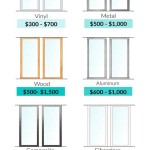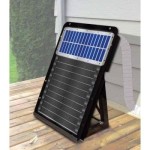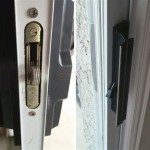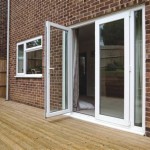Cost to Rescreen a Patio: A Comprehensive Guide
Rescreening a patio is a common home improvement project aimed at restoring functionality, aesthetics, and protection from insects and debris. The cost to rescreen a patio varies widely, influenced by several factors including the size of the area, the type of screening material used, labor costs, and the complexities involved in the project. This article provides a comprehensive overview of the costs associated with rescreening a patio, outlining the key factors that contribute to the overall expense and offering insights into how to manage the project effectively.
Understanding the Basic Cost Components
The total cost to rescreen a patio can be broken down into two primary components: materials and labor. Material costs encompass the screening material itself, spline (the cord that secures the screen to the frame), and any necessary fasteners or hardware. Labor costs cover the time and expertise required to remove the existing screening, prepare the frame, install the new screening, and clean up the work area. Understanding the relative proportion of these costs gives a homeowner a clearer picture of where to focus their attention when seeking cost-effective solutions.
Material costs are directly related to the type and quantity of screening selected. Screening materials range from standard fiberglass and aluminum to more durable and specialized options like pet-resistant or solar-screen fabrics. Labor costs, on the other hand, are influenced by the complexity of the job. A straightforward rescreening project with easily accessible frames will generally incur lower labor costs compared to a project involving intricate designs, significant frame repairs, or challenging access.
Geographic location also plays a significant role in both material and labor costs. Areas with a higher cost of living tend to have higher labor rates and potentially higher prices for building materials. Conversely, regions with a lower cost of living may offer more affordable options for rescreening services.
Key Factors Influencing the Overall Cost
Several key factors contribute to the overall cost of rescreening a patio. These factors interact with each other to determine the final price of the project, making it crucial to consider each element carefully when budgeting and planning.
1. Size of the Patio: The most obvious factor is the size of the patio to be rescreened. Larger patios require more screening material and more labor, directly increasing the overall cost. The area is typically measured in square feet, and contractors often base their estimates on a price per square foot for both materials and labor. Therefore, accurately measuring the patio area is essential for obtaining accurate cost estimates.
2. Type of Screening Material: The type of screening material selected significantly impacts the material cost. Fiberglass screening is the most common and affordable option, offering decent durability and visibility. Aluminum screening is slightly more expensive and provides greater strength and longevity. Specialized screening materials, such as pet-resistant or solar-screen options, command a premium due to their enhanced features and performance characteristics. Pet-resistant screening is designed to withstand scratching and tearing from pets, while solar-screen fabrics reduce heat gain and glare, contributing to a more comfortable patio environment.
3. Condition of the Existing Frame: The condition of the existing screen frame heavily influences the labor required and potentially the material costs. If the frame is in good condition, the rescreening process mainly involves removing the old screening, cleaning the frame, and installing the new screening. However, if the frame is damaged, rotted, or warped, repairs or even replacement may be necessary. Frame repairs can involve patching holes, reinforcing weak sections, or replacing damaged components. In severe cases, complete frame replacement may be required, adding significantly to the overall cost. The material of the frame itself (aluminum, wood, or vinyl) also influences the repair process and associated costs.
4. Labor Costs: Labor costs are determined by several factors, including the contractor's hourly rate, the complexity of the job, and the time required to complete the project. More experienced contractors typically charge higher rates due to their expertise and efficiency. Complex jobs, such as those involving intricate frame designs or difficult access, require more time and skill, resulting in higher labor costs. Some contractors charge a flat rate for the entire project, while others bill by the hour. It is essential to obtain multiple quotes from different contractors to compare pricing and ensure fair market value.
5. Additional Features and Upgrades: Beyond the basic rescreening process, homeowners may opt for additional features or upgrades that impact the cost. These can include installing new door hardware, adding kick plates to protect the screening at the bottom, or upgrading to a higher-quality spline. While these additions enhance the functionality and aesthetics of the screened patio, they also contribute to the overall expense.
6. Permitting and Inspections: Depending on local regulations, rescreening a patio may require permits and inspections. Permit fees can vary based on the size and scope of the project. Inspections are conducted to ensure that the rescreening work complies with building codes and safety standards. While the cost of permits and inspections may be relatively small compared to the overall project cost, they should be factored into the budget.
Cost Breakdown by Material Type
The choice of screening material is a primary driver of cost. A detailed breakdown of the approximate costs associated with different screening materials helps in making informed decisions.
Fiberglass Screening: Fiberglass screening is the most economical option, typically costing between $0.50 and $1.00 per square foot for the material alone. It is readily available in various colors and mesh sizes. Fiberglass is relatively easy to work with, making it a popular choice for DIY projects. However, it is less durable than other options and may require more frequent replacement.
Aluminum Screening: Aluminum screening is more durable and longer-lasting than fiberglass, with a material cost ranging from $1.00 to $2.00 per square foot. It is resistant to rust and corrosion, making it suitable for coastal environments. Aluminum screening is also more resistant to damage from pets and impacts. While it is slightly more challenging to install than fiberglass, its increased durability makes it a worthwhile investment for many homeowners.
Pet-Resistant Screening: Pet-resistant screening is specifically designed to withstand scratching and tearing from pets. These specialized materials can cost between $2.00 and $4.00 per square foot. It is made from heavy-duty polyester or vinyl-coated polyester, providing exceptional strength and durability. While more expensive than fiberglass or aluminum, pet-resistant screening can save money in the long run by reducing the need for frequent repairs or replacements.
Solar Screening: Solar screening is designed to reduce heat gain and glare, creating a more comfortable outdoor living space. These materials typically cost between $2.50 and $5.00 per square foot. Solar screening is available in various colors and densities, allowing homeowners to customize the level of sun protection. It can significantly reduce cooling costs and improve the usability of the screened patio during hot weather.
DIY vs. Professional Installation: Cost Considerations
Homeowners face the decision of whether to rescreen their patio themselves (DIY) or hire a professional contractor. Both options have advantages and disadvantages in terms of cost and effort.
DIY Rescreening: Doing it yourself can save on labor costs, potentially reducing the overall project expense. However, DIY rescreening requires certain tools, skills, and time. The initial investment in tools, such as a screen roller, spline tool, and utility knife, needs to be considered. Lack of experience can lead to errors, resulting in wasted materials and additional expenses. Moreover, DIY projects can be time-consuming, especially for larger patios or those with intricate frame designs.
Professional Installation: Hiring a professional contractor ensures that the rescreening is done correctly and efficiently. Contractors have the necessary tools, experience, and expertise to handle various types of screening materials and frame designs. While professional installation incurs labor costs, it can save time and prevent costly errors. Contractors also often provide warranties on their work, offering peace of mind.
The choice between DIY and professional installation depends on the homeowner's skills, time availability, and budget. For those with limited experience or time, hiring a professional contractor is generally the better option. For experienced DIY enthusiasts, rescreening a patio can be a rewarding and cost-effective project.
Tips for Minimizing Rescreening Costs
Several strategies can help homeowners minimize the cost of rescreening a patio without compromising the quality of the work.
1. Obtain Multiple Quotes: Requesting quotes from multiple contractors allows you to compare pricing and negotiate for the best value. Make sure that all quotes include a detailed breakdown of material and labor costs, as well as any additional fees.
2. Choose the Right Screening Material: Select a screening material that balances cost and durability. While specialized materials like pet-resistant or solar screening may be more expensive upfront, they can save money in the long run by reducing the need for frequent repairs or replacements. Consider the specific needs of your patio environment and choose a material that meets those needs without exceeding your budget.
3. Repair, Don't Replace: If the frame is in relatively good condition, consider repairing minor damage instead of replacing the entire frame. Patching holes, reinforcing weak sections, or replacing damaged components can be more cost-effective than complete frame replacement.
4. Schedule During Off-Peak Seasons: Demand for rescreening services tends to be higher during the spring and summer months. Scheduling the project during the off-peak seasons, such as fall or winter, may result in lower labor costs due to reduced demand.
5. Consider DIY for Simple Repairs: If you are comfortable with basic repairs, consider handling minor frame repairs or component replacements yourself. This can save on labor costs and give you greater control over the project.
6. Prepare the Area: Before the contractor arrives, clear the patio area of furniture and other obstructions. This will allow the contractor to work more efficiently, potentially reducing labor costs.
By carefully considering these factors and implementing cost-saving strategies, homeowners can effectively manage the expense of rescreening a patio and enjoy a functional and aesthetically pleasing outdoor living space.

Cost To Rescreen A Porch Or Patio Enclosure 2024

How Much Does A Screened In Porch Cost 2024 Data Angi

How Much Does It Cost To Rescreen Your Patio

Cost To Rescreen Or Repair A Porch Sunroom Enclosure Angi

How Much Does A Screened In Porch Cost 2024 Forbes Home

Cost To Rescreen A Porch Or Patio Enclosure 2024

How Much Does A Screened In Porch Or Patio Cost 2024

2024 Screen Door Repair Cost Angi

What S My Dream Screen Porch Going To Cost

How Much Is A Screen Porch Quora








